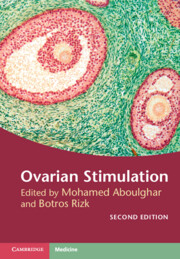Book contents
- Ovarian Stimulation
- Ovarian Stimulation
- Copyright page
- Dedication
- Contents
- Contributors
- About the Editors
- Foreword
- Preface to the first edition
- Preface to the second edition
- Section 1 Mild Forms of Ovarian Stimulation
- Section 2 Ovarian Hyperstimulation for IVF
- Section 3 Difficulties and Complications of Ovarian Stimulation and Implantation
- Section 4 Non-conventional Forms Used during Ovarian Stimulation
- Section 5 Alternatives to Ovarian Hyperstimulation and Delayed Transfer
- Chapter 23 Hyperprolactinemia
- Chapter 24 Ovarian Cautery for Polycystic Ovary Syndrome
- Chapter 25 Elective Freeze-All Embryos Policy
- Section 6 Procedures before, during, and after Ovarian Stimulation
- Index
- References
Chapter 25 - Elective Freeze-All Embryos Policy
from Section 5 - Alternatives to Ovarian Hyperstimulation and Delayed Transfer
Published online by Cambridge University Press: 14 April 2022
- Ovarian Stimulation
- Ovarian Stimulation
- Copyright page
- Dedication
- Contents
- Contributors
- About the Editors
- Foreword
- Preface to the first edition
- Preface to the second edition
- Section 1 Mild Forms of Ovarian Stimulation
- Section 2 Ovarian Hyperstimulation for IVF
- Section 3 Difficulties and Complications of Ovarian Stimulation and Implantation
- Section 4 Non-conventional Forms Used during Ovarian Stimulation
- Section 5 Alternatives to Ovarian Hyperstimulation and Delayed Transfer
- Chapter 23 Hyperprolactinemia
- Chapter 24 Ovarian Cautery for Polycystic Ovary Syndrome
- Chapter 25 Elective Freeze-All Embryos Policy
- Section 6 Procedures before, during, and after Ovarian Stimulation
- Index
- References
Summary
Allowing infertile couples to fulfill their longings of having children, assisted reproductive techniques (ART) have progressed rapidly day by day since 1978, the time when they were first introduced. Advances and improvements in the existing techniques and interventions in medicine (ovulation induction, embryo culture techniques and the selection criteria, culture media, and advanced techniques for embryo manipulation) lead the achievements in this area to progress further every day.
- Type
- Chapter
- Information
- Ovarian Stimulation , pp. 255 - 264Publisher: Cambridge University PressPrint publication year: 2022



